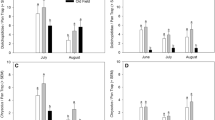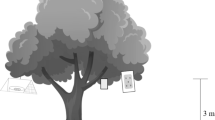Abstract
Natural habitats can affect the population dynamics of mobile insects, and the spatial and temporal effects on agricultural pest species may be especially relevant for tailoring management strategies to the farm context. Drosophila suzukii Matsumura (Diptera: Drosophilidae) is suspected to utilize woodland habitat for wild hosts and overwintering with possible adverse effects of woods on adjacent fruit crops. A two-year study in the Upper Midwest, USA examined if the amount of woodland in the landscape affects early season activity and relative abundance of D. suzukii in raspberry fields. Thirty-five farms were selected to span a gradient of low-to-high woodland area at the 1.5 km scale. The first capture of D. suzukii occurred earlier at farms in high woodland landscapes. However, woodland area was not correlated with metrics of D. suzukii abundance in raspberry (growth rate, peak, fall, or total fly catch) suggesting similar crop infestation risk across landscapes. However, woodland area was negatively correlated with fall fly catch in the adjacent woods and significantly more flies were captured in the woods than raspberry. This study suggests woodland landscapes affect early season crop risk and the high numbers of D. suzukii in the woods have implications for understanding overwintering.


Similar content being viewed by others
References
Asplen MK, Anfora G, Biondi A, Choi DS, Chu D, Daane KM, Gibert P, Gutierrez AP, Hoelmer KA, Hutchinson WD, Isaacs R, Jiang ZL, Kárpáti Z, Kimura MT, Pascual M, Philips CR, Plantamp C, Ponti L, Vétek G, Vogt H, Walton VM, Yu Y, Zappalà L, Desneux N (2015) Invasion biology of spotted wing Drosophila (Drosophila suzukii): a global perspective and future priorities. J Pest Sci 88:469–494
Atallah J, Teixeira L, Salazar R, Zaragoza G, Kopp A (2014) The making of a pest: the evolution of a fruit-penetrating ovipositor in Drosophila suzukii and related species. Proc R Soc London 281(1781):20132840
Bellamy DE, Sisterson MS, Walse SS (2013) Quantifying host potentials: indexing postharvest fresh fruits for spotted wing Drosophila, Drosophila suzukii. PLoS One 8(4):e61227
Bolda MP, Goodhue RE, Zalom FG (2010) Spotted Wing Drosophila: potential economic impact of a newly established pest. Agric Resour Econ Update. University of California Giannini Foundation of Agricultural Economics, 13:5–8
Bruck DJ, Bolda M, Tanigoshi L, Klick J, Kleiber J, DeFrancesco J, Spitler H (2011) Laboratory and field comparisons of insecticides to reduce infestation of Drosophila suzukii in berry crops. Pest Manag Sci 67:1375–1385
Burrack HJ, Smith JP, Pfeiffer DG, Koeher G, Laforest J (2012) Using volunteer-based networks to track Drosophila suzukii (Diptera: Drosophilidae) an invasive pest of fruit crops. J Integr Pest Manag 4:1–5
Burrack HJ, Asplen M, Bahder L, Collins J, Drummond FA, Guédot C, Isaacs R, Johnson D, Blanton A, Lee JC, Loeb G, Rodriguez-Saona C, Van Timmeren S, Walsh D, McPhie DR (2015) Multistate comparison of attractants for monitoring Drosophila suzukii (Diptera: Drosophilidae) in blueberries and caneberries. Environ Entomol, nvv002
Dalton DT, Walton VM, Shearer PW, Walsh DB, Caprile J, Isaacs R (2011) Laboratory survival of Drosophila suzukii under simulated winter conditions of the Pacific Northwest and seasonal field trapping in five primary regions of small and stone fruit production in the United States. Pest Manag Sci 67:1368–1374
De Ros G, Conci S, Pantezzi T, Savini G (2015) The economic impact of invasive pest Drosophila suzukii on berry production in the Province of Trento, Italy. J Berry Res 5:89–96
Gardiner MM, Landis DA, Gratton C, Schmidt N, O’Neal M, Mueller E, Chacon J, Heimpel GE, DiFonzo CD (2009) Landscape composition influences patterns of native and exotic lady beetle abundance. Divers Distrib 15:554–564
Goodhue RE, Bolda M, Farnsworth D, Williams JC, Zalom FG (2011) Spotted-wing drosophila infestation of California strawberries and raspberries: economic analysis of potential revenue losses and control costs. Pest Manag Sci 67:1396–1402
Hamby KA, Bolda MP, Sheehan ME, Zalom FG (2014) Seasonal monitoring for Drosophila suzukii (Diptera: Drosophilidae) in California commercial raspberries. Environ Entomol 43:1008–1018
Hampton E, Koski C, Barsoian O, Faubert H, Cowles RS, Alm SR (2014) Trapping to manage Drosophila suzukii (Diptera: Drosophilidae) in Vaccinium corymbosum (Ericales: Ericaceae). J Econ Entomol 107:1849–1857
Harris DW, Hamby KA, Wilson HE, Zalom FG (2014) Seasonal monitoring of Drosophila suzukii (Diptera: Drosophilidae) in a mixed fruit production system. J Asia-Pacific Entomol 17:857–864
Iglesias LE, Nyoike TW, Liburd OE (2014) Effect of trap design, bait type, and age on captures of Drosophila suzukii (Diptera: Drosophilidae) in berry crops. J Econ Entomol 107:1508–1518
Jakobs R, Gariepy TD, Sinclair BJ (2015) Adult plasticity of cold tolerance in a continental-temperate population of Drosophila suzukii. J Insect Physiol 79:1–9
Klick J, Yang WQ, Walton VM, Dalton DT, Hagler JR, Dreves AJ, Lee JC, Bruck DJ (2015) Distribution and activity of Drosophila suzukii in cultivated raspberry and surrounding vegetation. J Appl Entomol. doi:10.1111/jen.12234
Lee JC, Bruck DJ, Curry H, Edwards D, Haviland DR, Van Steenwyk RA, Yorgey BM (2011) The susceptibility of small fruits and cherries to the spotted-wing drosophila, Drosophila suzukii. Pest Manag Sci 67:1358–1367
Lee JC, Dreves AJ, Cave AM, Kawai S, Isaacs R, Miller JC, Van Timmeren S, Bruck DJ (2015) Infestation of wild and ornamental noncrop fruits by Drosophila suzukii (Diptera: Drosophilidae). Ann Entomol Soc Am, 1–13
Mallinger RE, Gratton C (2015) Species richness of wild bees, but not the use of managed honeybees, increases fruit set of a pollinator-dependent crop. J Appl Ecol 52:323–330
Mitsui H, Beppu K, Kimura MT (2010) Seasonal life cycles and resource use of flower- and fruit- feeding drosophilid flies (Diptera: Drosophilidae) in central Japan. Entomol Sci 13:60–67
Musser FR, Shelton AM (2003) Bt sweet corn and selective insecticides: impacts on pests and predators. J Econ Entomol 96:71–80
R Development Core Team (2012) R: a language and environment for statistical computing. R Foundation for Statistical Computing, Vienna
Roubos CR, Rodriguez-Saona C, Holdcraft R, Mason KS, Isaacs R (2014) Relative toxicity and residual activity of insecticides used in blueberry pest management: mortality of natural enemies. J Econ Entomol 107:277–285
Rusch A, Valantin-Morison M, Sarthou JP, Roger-Estrade J (2013a) Effect of crop management and landscape context on insect pest populations and crop damage. Agr Ecosyst Environ 166:118–125
Rusch A, Valantin-Morison M, Sarthou JP, Roger-Estrade J (2013b) Effect of crop management and landscape context on insect pest populations and crop damage. Agric Ecosyst Environ 166:118–125
Stephens AR, Asplen MK, Hutchinson WD, Venette RC (2015) Cold hardiness of winter acclimated Drosophila suzukii (Diptera: Drophilidae) adults. Environ Entomol, nvv134
Tochen S, Dalton DT, Wiman N, Hamm C, Shearer PW, Walton VM (2014) Temperature-related development and population parameters for Drosophila suzukii (Diptera: Drosophilidae) on cherry and blueberry. Environ Entomol 43:501–510
Tscharntke T, Klein AM, Kruess A, Steffan-Dewenter I, Thies C (2005) Landscape perspectives on agricultural intensification and biodiversity–ecosystem service management. Ecol Lett 8:857–874
Van Timmeren S, Isaacs R (2013) Control of spotted wing drosophila, Drosophila suzukii, by specific insecticides and by conventional and organic crop protection programs. Crop Prot 54:126–133
Wiman NG, Walton VM, Dalton DT, Anfora G, Burrack HJ, Chiu JC, Daane KM, Grassi A, Miller B, Tochen S, Wang X, Ioriatti C (2014) Integrating temperature-dependent life table data into a matrix projection model for Drosophila suzukii population estimation. PLoS One 9(9):e106909
Wise JC, Vanderpoppen R, Vandervoort C, O’Donnell C, Isaacs R (2014) Curative activity contributes to control of spotted-wing drosophila (Diptera: Drosophilidae) and blueberry maggot (Diptera: Tephritidae) in highbush blueberry. Can Entomol, 1–9
Wu JY, Anelli CM, Sheppard WS (2011) Sub-lethal effects of pesticide residues in brood comb on worker honey bee (Apis mellifera) development and longevity. PLoS One 6(2):e14720
Zerulla FN, Schmidt S, Streitberger M, Zebitz CPW, Zelger R (2015) On the overwintering ability of Drosophila suzukii in South Tyrol. J Berry Research. doi:10.3233/JBR-150089
Acknowledgments
We extend our thanks to the growers in Wisconsin, Michigan, and Minnesota who participated in the study. Caitlin Bergstrom, Abigail Cohen, Tressa Franzmeier, Kiley Friedrich, Kathryn Hietala-Henschell, Maria Kieft, Taylor Mann, Ian McCririe, Keith Phelps, and Eren Sipahi provided field and lab assistance, and we thank Murray Clayton and Tim Meehan for assistance with statistical analysis.
Author contributions
EP and CGratton conceived and designed the research. AB, EP, and SVT conducted field and laboratory research. EP and CGratton analyzed data. EP wrote manuscript. All authors read and approved the manuscript.
Funding
Funding for this project was provided by a University of Wisconsin Center for Integrated Agricultural Systems grant and the USDA National Institute of Food and Agriculture, North Central IPM Center project 2013-34103-21338.
Author information
Authors and Affiliations
Corresponding author
Ethics declarations
Conflict of interest
The authors declare that they have no conflict of interest.
Additional information
Communicated by A. Biondi.
Rights and permissions
About this article
Cite this article
Pelton, E., Gratton, C., Isaacs, R. et al. Earlier activity of Drosophila suzukii in high woodland landscapes but relative abundance is unaffected. J Pest Sci 89, 725–733 (2016). https://doi.org/10.1007/s10340-016-0733-z
Received:
Revised:
Accepted:
Published:
Issue Date:
DOI: https://doi.org/10.1007/s10340-016-0733-z




